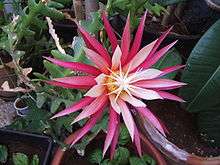Selenicereus anthonyanus
| Fish Bone Cactus | |
|---|---|
 | |
| Photo: Floriano Calcagnile | |
| Scientific classification | |
| Kingdom: | Plantae |
| (unranked): | Angiosperms |
| (unranked): | Eudicots |
| (unranked): | Core eudicots |
| Order: | Caryophyllales |
| Family: | Cactaceae |
| Subfamily: | Cactoideae |
| Tribe: | Hylocereeae |
| Genus: | Selenicereus |
| Species: | S. anthonyanus |
| Binomial name | |
| Selenicereus anthonyanus (Alexander) D. Hunt | |
| Synonyms | |
|
| |
Selenicereus anthonyanus is a cactus species native to southern Mexico. It is grown as an ornamental because of its beautiful nocturnal flowers and unusual stems. Common names include fish bone cactus, rick rack cactus, zig-zag cactus and St. Anthony's rik-rak.
Etymology
This species is named for Dr. Harold E. Anthony who first flowered this species in June 1950. The former generic epiptet Cryptocereus (literally, "hidden cereus") recalls the fact that the species remained long unknown in a region that had been thoroughly investigated.
History
Mr. Thomas MacDougall found this species in 1946. He thought he had found a close relative to Epiphyllum anguliger. When it flowered in the greenhouses of Dr. Harold E. Anthony in Jersey in 1950 it was obvious that this was a great novelty. The species is rarely collected and most plants in cultivation descend from this first collection.
Origin and habitat
S. anthonyanus originates in the rainforests of Chiapas, Mexico where it grows at altitudes of 700 metres (2,300 ft) to 800 metres (2,600 ft).
Systematics
This is an isolated species with no close allies. Selenicereus chrysocardium seems to be the closest relative. Two other epiphytic cacti from other genera show similar strongly notched flat stems and which, when not in flower, are not readily distinguishable from this species: these are Epiphyllum anguliger and Weberocereus imitans.
Cultivation
An easily cultivated, fast growing epiphyte, S. anthonyanus needs a compost containing plenty of humus and sufficient moisture in summer. Should not be kept under 4 °C (39 °F) in winter. Can be grown in semi–shade or full sun. Extra light in the early spring will stimulate budding. Flowers only open for one night and are very fragrant, as to attract nocturnal pollinators. Flowers in late spring or early summer.
Hybrids
- 'Corinna Paetz' (S. anthonyanus × 'Feuerauber')
- ×Disoselenicereus 'Stauch's Mandarin' by Dr. Stauch (Disocactus × smithii × S. anthonyanus)
- ×Disoselenicereus 'Noris' by R. Gräser (Disocactus speciosus × S. anthonyanus).
- ×Disoselenicereus 'Wormatia' by Dr. Stauch (Disocactus × smithii × S. anthonyanus).
- ×Disoselenicereus 'Müllers Mandarin' ('Stauch's Mandarin' × Disocactus speciosus)
Description
Stems scandent or climbing, branches in clusters at intervals along the stem, to 1 m long or more, 7–15 cm wide, flat with few aerial roots; the lobes 25–45 mm long and 10–16 mm wide, somewhat tapered towards the rounded apex; areoles small, near central nerv, spines 3, short; epidermis green to yellowish green, smooth. Flowers 10–12 cm long, (10-) 14-17 (-20) cm in Ø, nocturnal, very fragrant; pericarpal 15–20 mm long, green, bracteoles 1–2 mm long, olive green, their axils with dirty gray wool, grayish-brown bristles and stout, pale brown spines, 1–3 mm long; receptacle 3–4 cm long, 1–5 cm in Ø, terete, bracteoles 3–6 mm long, ovate-lanceolate, the lowermost with wool and bristles, the upper naked, the uppermost 8–10 mm long, madder purple; outer tepals outermost 1–2 cm long, similar to bracteoles, inner 6 cm long, spreading-recurved, lanceolate, madder purple; intermediate tepals 5, lanceolate, acute; inner tepals ca 10, 6 cm, lanceolate-acute, erect-spreading, cream, outermost cream with lower margins madder purple; stamens short, 15 mm long, yellowish; style 6.5–7 cm long, 6 mm thick above the throat, in the throat abruptly contracted to 4 mm thick, cream, stigma lobes 12-14, lanceolate, 16–18 mm long. Fruit ovoid, 6 x 5 cm long, fragrant, areoles 4 mm with spines 1–2 cm, dark green. Seeds 2 x 1.5 mm, black.